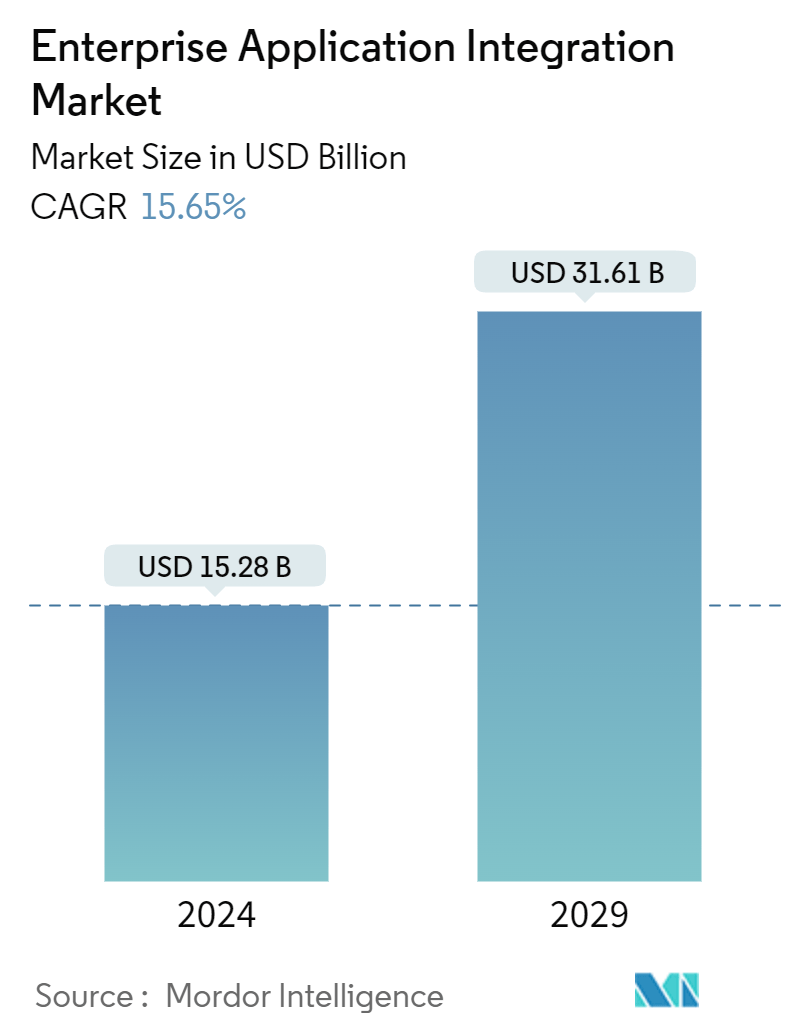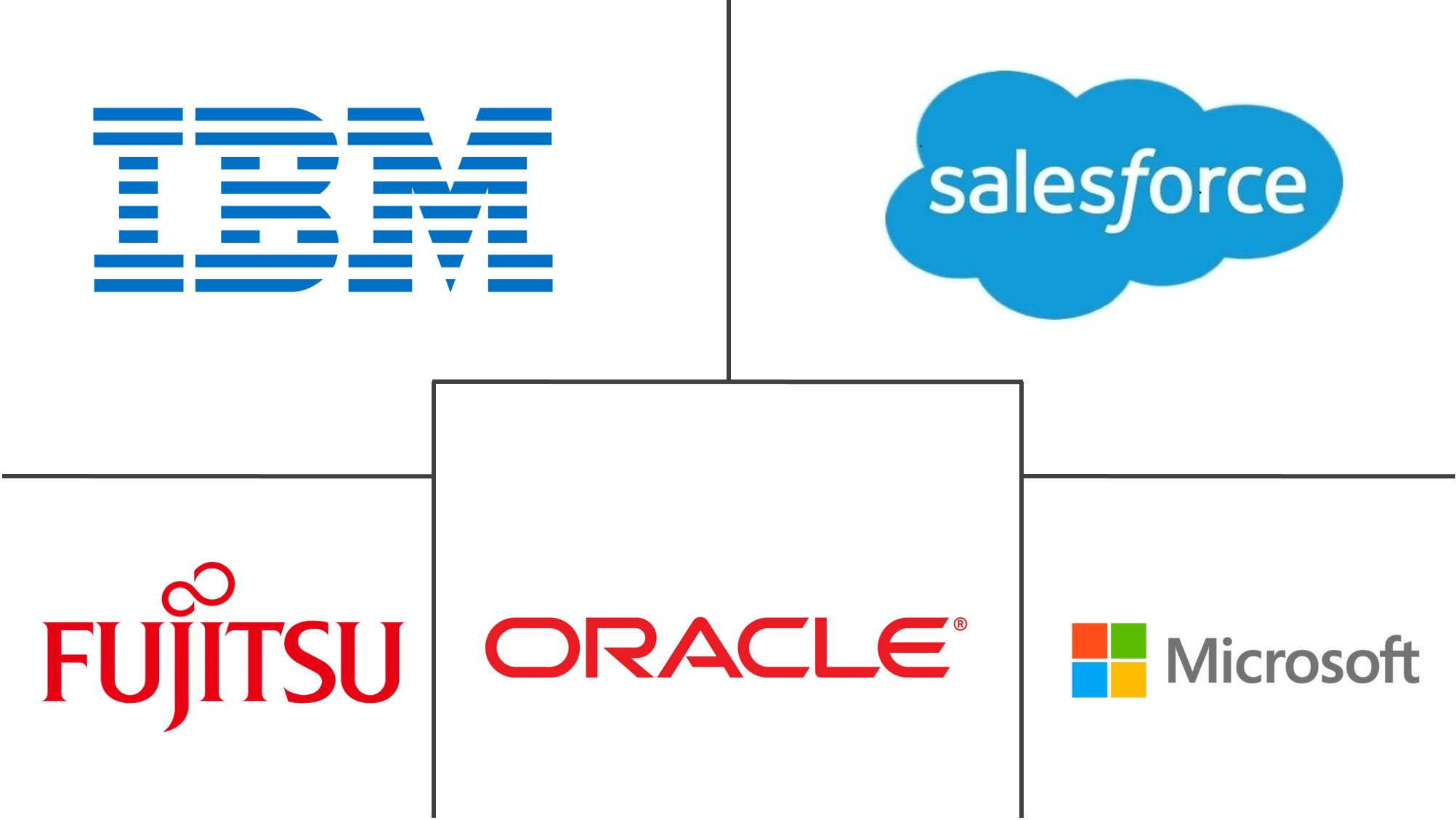Market Size of Enterprise Application Integration Industry

| Study Period | 2019 - 2029 |
| Market Size (2024) | USD 15.28 Billion |
| Market Size (2029) | USD 31.61 Billion |
| CAGR (2024 - 2029) | 15.65 % |
| Fastest Growing Market | North America |
| Largest Market | North America |
Major Players
*Disclaimer: Major Players sorted in no particular order |
Enterprise Application Integration Market Analysis
The Enterprise Application Integration Market size is estimated at USD 15.28 billion in 2024, and is expected to reach USD 31.61 billion by 2029, growing at a CAGR of 15.65% during the forecast period (2024-2029).
Digital Transformation Reshaping Enterprise Landscapes
Digital transformation is revolutionizing industries across the board. As businesses evolve, the need for seamless integration of diverse applications becomes paramount. Enterprise Application Integration (EAI) solutions are at the forefront of this transformation, enabling organizations to unify databases and workflows associated with business applications. The adoption of EAI is driven by the increasing complexity of enterprise software ecosystems. According to Okta's "Businesses at Work" report, large organizations deploy an average of 187 applications, showcasing a consistent rise in application utilization globally. This trend underscores the critical need for robust enterprise application integration solutions.
Integration Challenges:
- Disparate Systems: Businesses often operate with incompatible frameworks, hindering data exchange between ERP, CRM, and other critical systems.
- Automation Hurdles: The lack of integration makes automating simple tasks challenging, impacting operational efficiency.
- Financial Impact: Cleo's report reveals that 24% of supply chain companies lose over USD 500,000 annually due to inadequate software system integrations.
EAI Solutions:
- Middleware Infrastructure: EAI introduces a secure platform for open data sharing between heterogeneous applications and legacy devices.
- Unified Approach: By removing data from application restrictions, EAI middleware platforms aid in centralized data management and integration.
- Operational Efficiency: Integration streamlines information sharing and provides ease in controlling data across cloud computing, Big Data, and IoT technologies.
Real-time Data Access: The Cornerstone of Agile Enterprises
The demand for real-time data access and management is surging as businesses strive for agility and operational efficiency. Real-time insights are crucial for making informed decisions, improving customer experiences, and driving personalization efforts. This trend is propelling investments in cloud-based enterprise integration solutions that can handle the complexity and volume of modern data repositories.
Market Response:
- Cloud Connectivity: Qlik introduced Qlik-cloud data connectivity, an Integration Platform as a Service (iPaaS) solution, linking all enterprise data sources to the cloud in real-time.
- On-premise Advantages: On-premise implementations offer real-time monitoring of business operations with enhanced data confidentiality.
- Comprehensive Solutions: Persistent's Enterprise Integration Services enable seamless interfacing of software applications, providing a consistent, real-time view of data across multiple channels.
Industry Impact:
- Performance Optimization: Real-time data integration allows for immediate insights into total business performance across software-defined enterprises.
- Collaborative Efficiency: EAI tools and technologies are evolving to deliver real-time insights, fostering successful cooperation and information exchange across multiple applications.
- Managed Complexity: Single services are emerging to handle issues across a diverse range of infrastructure and applications more effectively.
API-Driven Integration: Powering the Connected Enterprise
The proliferation of mobile applications, IoT devices, and wearables is driving the need for API-centric integration. Real-time, API-driven integration enables the creation of applications that can monitor various parameters on the go, facilitating seamless data flow and synchronization across multiple platforms.
Connectivity Scale:
- Device Proliferation: Cisco projects that 500 billion devices will be connected to the Internet by 2030, emphasizing the critical role of EAI in managing this vast ecosystem.
- Data Synchronization: Real-time application integration ensures data consistency across PCs, laptops, and handheld devices
Enterprise Impact:
- Ecosystem Binding: As digital transformation advances, enterprise software integration is shifting from back-end to a critical role in binding the entire ecosystem.
- Architectural Flexibility: EAI solutions are evolving to support cloud and on-premise environments, agile delivery, and plug-and-play architectures.
Industry-Specific Adoption TrendsThe adoption of EAI solutions varies across industries, with IT and telecom, BFSI, and manufacturing sectors leading the charge. Each sector leverages EAI to address unique challenges and capitalize on emerging opportunities.
IT and Telecom:
- Market Leadership: The IT and telecom segment is projected to reach USD 7.28 billion by 2027, growing at a CAGR of 17.64%.
- Telecom Integration: Enterprise software integration projects are crucial for integrating custom and market application systems in telecom operations, balancing technology with business imperatives.
BFSI Sector:
- Digital Payments: The rise of digital payment methods is driving the need for robust data management systems, fueling EAI market growth.
- Innovative Platforms: BlocPal International Inc.'s development of a unique physical and virtual financial services platform exemplifies the sector's push towards integrated digital solutions.
Manufacturing:
Knowledge Engineering: EAI is critical in integrating dispersed and autonomous manufacturing systems, supporting paradigms like virtual enterprise and mass customization.
- Competitiveness: Efficient application of IT and knowledge-based engineering through EAI enhances firms' ability to respond swiftly to market developments.
- Future Outlook: Evolving Integration Landscape : The future of Enterprise Application Integration is characterized by increasing complexity and the need for more sophisticated, agile solutions. As organizations continue to rely heavily on technology, the demand for integrating diverse applications will only intensify
Emerging Trends:
- Expanded Integration Scope: Future EAI solutions will need to consider a vastly larger collection of endpoints both inside and outside the organization.
- Rapid Innovation: The frequency of changes in integration requirements is accelerating, necessitating more flexible and responsive EAI platforms.
- Mobile Integration: It's projected that 20% of integration spending will be directed towards integrating data on mobile devices, addressing challenges like intermittent connectivity and variable throughput
Strategic Imperatives:
- Balancing Stability and Innovation: IT leaders must maintain control over critical systems while fostering rapid iteration of applications accessing those systems.
- Prefetching and Caching: Mobile apps are increasingly employing sophisticated data prefetching and caching strategies to compensate for connectivity issues.
- Continuous Adaptation: EAI solutions must evolve to support the rapid pace of innovation that distinguishes digital transformation initiatives.
Enterprise Application Integration Industry Segmentation
Enterprise application integration software refers to server software, hardware, or virtual appliances installed on-premise inside a data center, or offered in a public or private cloud, to integrate applications. It handles the workflow or orchestration of automated multistep requests requiring coordinated interactions across applications, back-end services, and data stores. The study tracks the various types of integration platforms to support on-premise, cloud, and iPaaS (integration Platform-as-a-Service) and end users in the market.
The enterprise application integration market is segmented by deployment type (on-premise, cloud, hybrid), by organization size (large enterprises, small & medium-sized enterprises), by end-user industry (BFSI, IT & telecom, healthcare, retail, government, manufacturing), and by geography (North America, Europe, Asia-Pacific, Latin America, Middle East & Africa). The market sizes and forecasts are provided in terms of value (USD) for all the above segments.
| Deployment Type | |
| On-premise | |
| Cloud | |
| Hybrid |
| Organisation Size | |
| Large Enterprises | |
| Small and Medium-sized Enterprises |
| End-user Industry | |
| BFSI | |
| IT and Telecom | |
| Healthcare | |
| Retail | |
| Government | |
| Manufacturing | |
| Other End-user Industries |
| Geography | |
| North America | |
| Europe | |
| Asia Pacific | |
| Latin America | |
| Middle East and Africa |
Enterprise Application Integration Market Size Summary
The enterprise application integration (EAI) market is poised for significant growth, driven by the increasing need for businesses to streamline data sharing across diverse applications and platforms. EAI facilitates the seamless exchange of information between disparate systems, ensuring consistency and accuracy in business operations. As organizations shift towards Platform as a Service (PaaS) solutions, the focus is on overcoming the limitations of traditional integration methods. This transition is fueled by the need to manage and integrate data more effectively, particularly as businesses adopt cloud computing, Big Data, and IoT technologies. The market is also witnessing a trend towards middleware infrastructures that enable secure and open data sharing among heterogeneous applications, which is crucial for automating business processes.
The North American region leads the enterprise application integration market, supported by its advanced technological infrastructure and the presence of major industry players like Oracle, IBM, and Microsoft. These companies are actively developing new technologies that drive market expansion. The preference for open-source solutions is growing, offering cost-effective alternatives to proprietary software, which is particularly appealing to small and medium-sized enterprises. The market is moderately fragmented, with key players engaging in strategic partnerships and acquisitions to enhance their offerings and maintain a competitive edge. As digital transformation continues to be a priority for businesses, the demand for EAI solutions is expected to rise, with a focus on integrating cloud services and ensuring data integrity and privacy.
Enterprise Application Integration Market Size - Table of Contents
-
1. MARKET INSIGHTS
-
1.1 Market Overview
-
1.2 Industry Value Chain Analysis
-
1.3 Industry Attractiveness - Porter's Five Forces Analysis
-
1.3.1 Threat of New Entrants
-
1.3.2 Bargaining Power of Buyers
-
1.3.3 Bargaining Power of Suppliers
-
1.3.4 Threat of Substitutes
-
1.3.5 Degree of Competition
-
-
1.4 Technology Snapshot
-
-
2. MARKET SEGMENTATION
-
2.1 Deployment Type
-
2.1.1 On-premise
-
2.1.2 Cloud
-
2.1.3 Hybrid
-
-
2.2 Organisation Size
-
2.2.1 Large Enterprises
-
2.2.2 Small and Medium-sized Enterprises
-
-
2.3 End-user Industry
-
2.3.1 BFSI
-
2.3.2 IT and Telecom
-
2.3.3 Healthcare
-
2.3.4 Retail
-
2.3.5 Government
-
2.3.6 Manufacturing
-
2.3.7 Other End-user Industries
-
-
2.4 Geography
-
2.4.1 North America
-
2.4.2 Europe
-
2.4.3 Asia Pacific
-
2.4.4 Latin America
-
2.4.5 Middle East and Africa
-
-
Enterprise Application Integration Market Size FAQs
How big is the Enterprise Application Integration Market?
The Enterprise Application Integration Market size is expected to reach USD 15.28 billion in 2024 and grow at a CAGR of 15.65% to reach USD 31.61 billion by 2029.
What is the current Enterprise Application Integration Market size?
In 2024, the Enterprise Application Integration Market size is expected to reach USD 15.28 billion.

